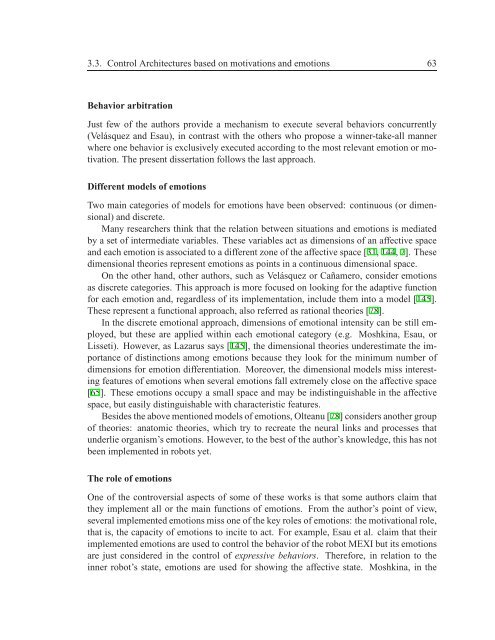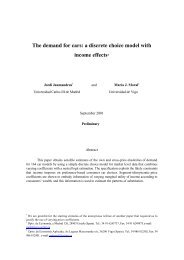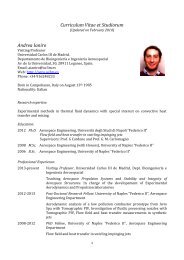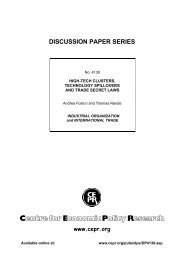TESIS DOCTORAL - Robotics Lab - Universidad Carlos III de Madrid
TESIS DOCTORAL - Robotics Lab - Universidad Carlos III de Madrid
TESIS DOCTORAL - Robotics Lab - Universidad Carlos III de Madrid
Create successful ePaper yourself
Turn your PDF publications into a flip-book with our unique Google optimized e-Paper software.
3.3. Control Architectures based on motivations and emotions 63Behavior arbitrationJust few of the authors provi<strong>de</strong> a mechanism to execute several behaviors concurrently(Velásquez and Esau), in contrast with the others who propose a winner-take-all mannerwhere one behavior is exclusively executed according to the most relevant emotion or motivation.The present dissertation follows the last approach.Different mo<strong>de</strong>ls of emotionsTwo main categories of mo<strong>de</strong>ls for emotions have been observed: continuous (or dimensional)and discrete.Many researchers think that the relation between situations and emotions is mediatedby a set of intermediate variables. These variables act as dimensions of an affective spaceand each emotion is associated to a different zone of the affective space [31, 144, 7]. Thesedimensional theories represent emotions as points in a continuous dimensional space.On the other hand, other authors, such as Velásquez or Cañamero, consi<strong>de</strong>r emotionsas discrete categories. This approach is more focused on looking for the adaptive functionfor each emotion and, regardless of its implementation, inclu<strong>de</strong> them into a mo<strong>de</strong>l [145].These represent a functional approach, also referred as rational theories [78].In the discrete emotional approach, dimensions of emotional intensity can be still employed,but these are applied within each emotional category (e.g. Moshkina, Esau, orLisseti). However, as Lazarus says [145], the dimensional theories un<strong>de</strong>restimate the importanceof distinctions among emotions because they look for the minimum number ofdimensions for emotion differentiation. Moreover, the dimensional mo<strong>de</strong>ls miss interestingfeatures of emotions when several emotions fall extremely close on the affective space[65]. These emotions occupy a small space and may be indistinguishable in the affectivespace, but easily distinguishable with characteristic features.Besi<strong>de</strong>s the above mentioned mo<strong>de</strong>ls of emotions, Olteanu [78] consi<strong>de</strong>rs another groupof theories: anatomic theories, which try to recreate the neural links and processes thatun<strong>de</strong>rlie organism’s emotions. However, to the best of the author’s knowledge, this has notbeen implemented in robots yet.The role of emotionsOne of the controversial aspects of some of these works is that some authors claim thatthey implement all or the main functions of emotions. From the author’s point of view,several implemented emotions miss one of the key roles of emotions: the motivational role,that is, the capacity of emotions to incite to act. For example, Esau et al. claim that theirimplemented emotions are used to control the behavior of the robot MEXI but its emotionsare just consi<strong>de</strong>red in the control of expressive behaviors. Therefore, in relation to theinner robot’s state, emotions are used for showing the affective state. Moshkina, in the






